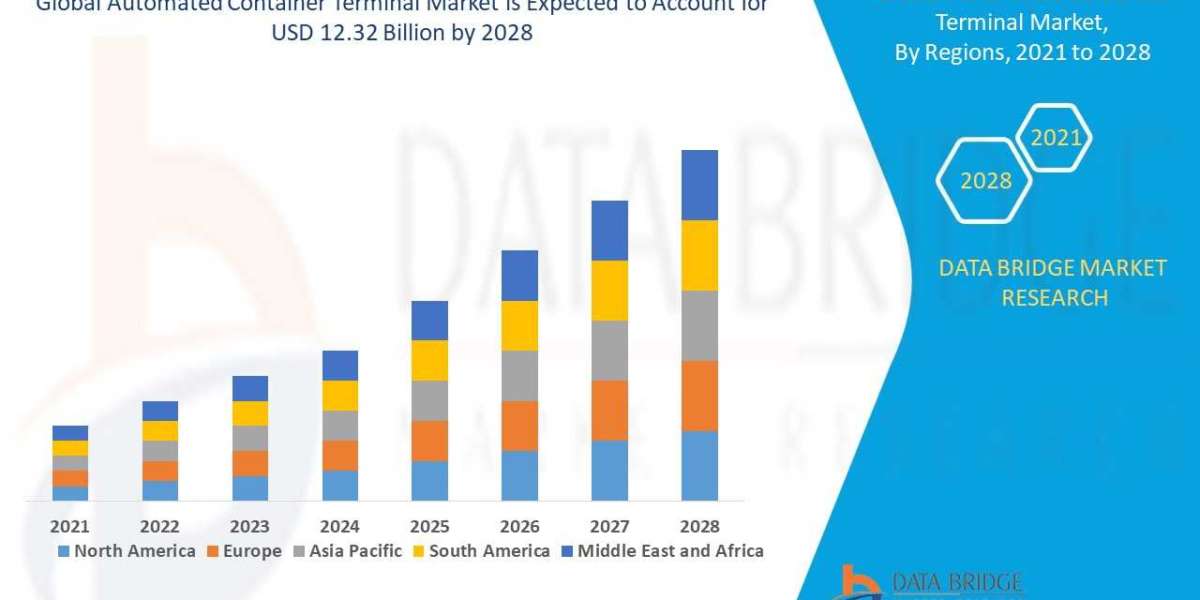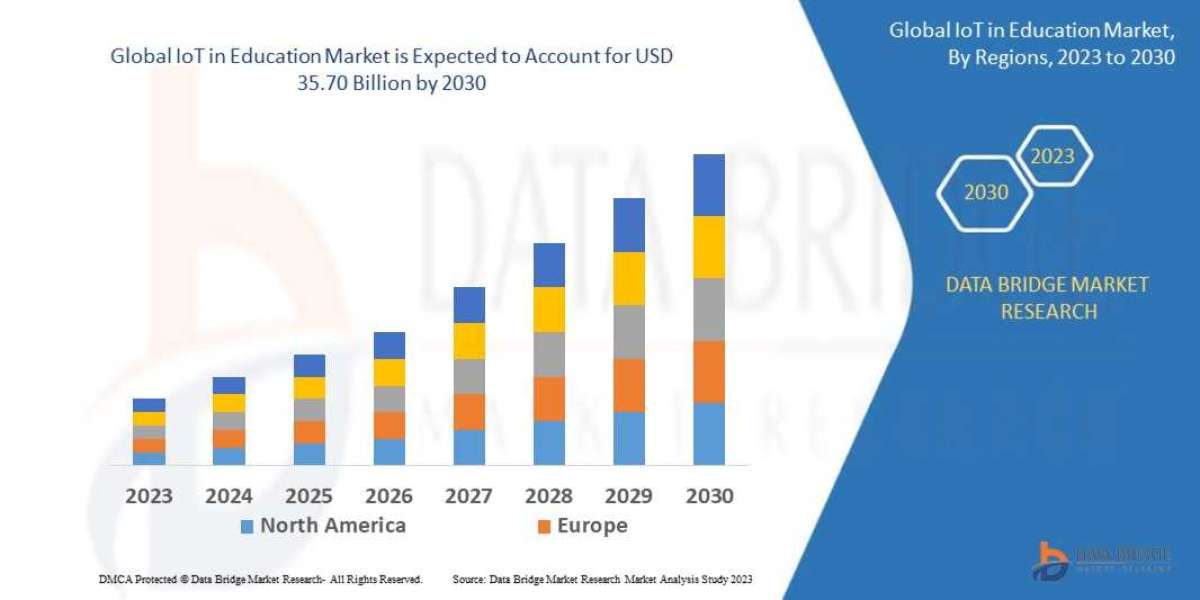
"Automated Container Terminal Market Size And Forecast by 2031
The study also emphasizes the broader implications of the strategies employed by these companies on the Automated Container Terminal Market. Their innovations and market contributions not only shape the industry today but also pave the way for its future trajectory. By analyzing these companies, the report equips stakeholders with actionable insights to understand competitive positioning, identify growth opportunities, and devise strategies to thrive in this dynamic and evolving market landscape.
Due to the increase in demand for large container ships, the demand for automated container terminal is subsequently rising. Data Bridge Market Research analyses that the automated container terminal market will exhibit a CAGR of 2.9% for the forecast period of 2021-2028. This means that the current market value will rise up to USD 12.32 billion by the year 2028.
The Automated Container Terminal Market research report offers valuable insights into industry statistics, including market size, share, and revenue performance. It provides a comprehensive overview of key players, their strategies, and their impact on the competitive landscape. This analysis helps stakeholders identify areas of growth and prioritize investment opportunities.
Get a Sample PDF of Report - https://www.databridgemarketresearch.com/request-a-sample/?dbmr=global-automated-container-terminal-market
Which are the top companies operating in the Automated Container Terminal Market?
The Top 10 Companies in Automated Container Terminal Market include leading firms. These companies are known for their strong market presence, innovative products, and ability to meet customer demands. They continue to drive growth in the industry through their commitment to quality and innovation, making them key players in the Automated Container Terminal Market.
**Segments**
- **Technology**: The automated container terminal market can be segmented based on technology into semi-automated terminals and fully automated terminals. Semi-automated terminals involve a combination of manual labor and automated technologies to handle container operations. On the other hand, fully automated terminals are equipped with advanced technologies such as robotic cranes, automated guided vehicles (AGVs), and artificial intelligence for a completely autonomous operation.
- **Component**: Another key segmentation is based on components, which include hardware and software. The hardware components of automated container terminals encompass various machinery and equipment like cranes, sensors, cameras, and control systems. The software segment includes automation software, terminal operating systems (TOS), and other digital solutions that facilitate efficient terminal operations.
- **End-User**: The market can also be segmented based on end-users such as marine ports, inland ports, and container depots. Each end-user segment has specific requirements and challenges, driving the adoption of automated solutions to enhance operational productivity, safety, and cost-effectiveness.
**Market Players**
- **ABB Ltd.**: ABB is a leading provider of industrial automation and robotics solutions, offering a range of products for automated container terminals such as robotic cranes, electrification systems, and control technologies.
- **Konecranes**: Konecranes specializes in container handling equipment and automation solutions for ports and terminals. The company's portfolio includes automated stacking cranes, straddle carriers, and intelligent software systems for efficient terminal operations.
- **Cargotec Corporation**: Cargotec is a key player in the automated container terminal market, offering automation technologies through its Kalmar and Navis brands. The company provides automated container handling systems, software solutions, and services to optimize terminal performance.
- **Liebherr Group**: Liebherr offers a range of automated container crane systems, reachstackers, and terminal tractors for seamless cargo handling operations. The company's innovative technologies focus on enhancing productivity and safety in container terminals.
For moreThe automated container terminal market is witnessing significant growth and transformation due to advancements in technology, changing industry dynamics, and increasing demand for efficient and cost-effective terminal operations. One of the emerging trends in the market is the integration of Internet of Things (IoT) and data analytics solutions to optimize container handling processes, improve visibility and transparency, and enhance decision-making capabilities. By leveraging IoT sensors, RFID technology, and cloud-based platforms, terminal operators can track container movements in real-time, predict equipment maintenance needs, and streamline overall terminal operations for increased productivity and efficiency.
Additionally, the growing focus on sustainability and environmental conservation is driving the adoption of eco-friendly solutions in automated container terminals. Terminal operators are increasingly investing in electrification technologies, renewable energy sources, and energy-efficient equipment to reduce carbon emissions, minimize environmental impact, and comply with regulatory requirements. With the rising emphasis on green initiatives, automated container terminals are transitioning towards greener practices to create a more sustainable and eco-conscious operating environment.
Furthermore, the market is witnessing a surge in partnerships and collaborations between technology providers, terminal operators, and logistics stakeholders to develop integrated solutions that address the complex challenges faced by the industry. By combining expertise in automation, digitalization, and logistics management, companies are co-innovating to create seamless end-to-end solutions that optimize container terminal operations, enhance supply chain visibility, and improve overall customer satisfaction. These strategic partnerships enable market players to leverage their complementary strengths, resources, and technologies to deliver comprehensive solutions that meet the evolving needs of the automated container terminal market.
Moreover, as global trade volumes continue to rise, there is a pressing need for scalable and adaptable automated container terminal solutions that can efficiently handle large volumes of containers while maintaining operational efficiency and cost-effectiveness. Market players are increasingly focusing on developing flexible and modular automation systems that can be easily integrated into existing terminal infrastructure, upgraded to meet changing requirements, and scaled up to accommodate future growth. By offering versatile and customizable solutions, companies are catering to the diverse needs of different terminal operators**Market Players**
- Cargotec Corporation
- Konecranes
- Liebherr-International Deutschland GmbH
- ABB
- KUNZ Aircraft Equipment
- CyberLogitec
- Camco
- IDENTEC SOLUTIONS AG
- ORBCOMM
- Orbita Ports Terminals
- PACECO CORP.
- TOTAL SOFT BANK LTD.
- INFORM Software
- LogStar
- Infyz
- Tideworks
- Loginno Logistic Innovation ltd.
- WCS – World Crane Services FZE
- Starcom Systems Ltd
The automated container terminal market is experiencing rapid expansion and evolution driven by technological advancements, industry shifts, and a growing demand for streamlined and cost-effective terminal operations. One significant trend in this market is the integration of Internet of Things (IoT) and data analytics solutions to optimize container handling processes, enhance visibility, improve decision-making, and boost overall operational efficiency. By utilizing IoT sensors, RFID technology, and cloud-based platforms, terminal operators can monitor container movements in real-time, predict equipment maintenance requirements, and optimize terminal operations for increased productivity.
Another key driver in the market is the increasing emphasis on sustainability and environmental responsibility, leading to the adoption of eco-friendly practices in automated container terminals. Terminal operators are investing in electrification technologies, renewable energy sources, and energy-efficient equipment to reduce carbon footprints, minimize environmental impact, and meet regulatory standards. This focus on green initiatives is reshaping automated container
Explore Further Details about This Research Automated Container Terminal Market Report https://www.databridgemarketresearch.com/reports/global-automated-container-terminal-market
Key Insights from the Global Automated Container Terminal Market :
- Comprehensive Market Overview: The Automated Container Terminal Market is witnessing rapid expansion, fueled by increasing demand for advanced solutions and evolving consumer needs.
- Industry Trends and Projections: The market is projected to grow at a CAGR of X%, with a notable shift towards digitalization and automation in the coming years.
- Emerging Opportunities: There is a rising demand for eco-friendly products and services, creating new business avenues within the market.
- Focus on RD: Companies are prioritizing innovation and research to develop next-generation products and enhance competitive advantages.
- Leading Player Profiles: Market leaders continue to drive growth through strategic acquisitions and product innovation.
- Market Composition: The market is segmented by product type, region, and application, with a mix of both established and emerging players.
- Revenue Growth: The market is experiencing significant revenue growth, attributed to increased consumer spending and the expansion of digital services.
- Commercial Opportunities: There are substantial opportunities for expansion in untapped regions, particularly in developing economies where demand is rising.
Our reports cater to diverse audiences by offering localized analyses in multiple regional languages. These reports provide tailored insights for specific regions, enabling businesses and stakeholders to access relevant information for informed strategies.
Get More Reports:
Middle East and Africa Genital Warts Market Challenges and Insights: Growth, Share, Value, Size, and Scope
Middle East and Africa Rehabilitation Therapy Services Market Challenges and Growth Drivers: Share, Value, Size, and Trends
Asia-Pacific Dental Implants Market Industry Statistics and Trends Analysis: Growth, Share, Value, and Size
North America Ovarian Cancer Diagnostics Market Industry Statistics: Growth, Share, Value, Size, and Scope
North America Forestry Equipment Market Growth and Outlook: Share, Value, Size, Trends, and Analysis
North America Sports Apparel Market Size and Scope Analysis: Growth, Share, Value, and Trends
Europe Gamma Butyrolactone Market Companies and Growth Overview: Share, Value, Size, Trends, and Analysis
Middle East and Africa Cannabidiol (CBD) Market Challenges and Drivers Trends: Growth, Share, Value, Size, and Analysis
Middle East and Africa Food Storage Container Market Leaders and Trends Analysis: Growth, Share, Value, Size, and Scope
North America Proximity Sensor Market Growth Drivers: Trends, Statistics, Value, and Size
Data Bridge Market Research:
Contact Us:
Data Bridge Market Research
US: +1 614 591 3140
UK: +44 845 154 9652
APAC: +653 1251 975














